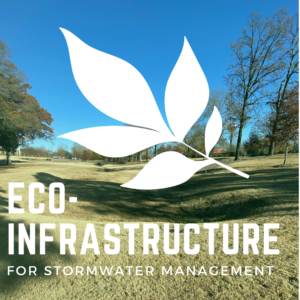Social Sustainability
Social Sustainability is the dimension of sustainability concerned with the well-being and longevity of a community. A community is made up of people as well as the places where they live; it is both a social environment and a physical environment. Work to improve social environments is nothing new, yet social sustainability is often the least well-known dimension of sustainability. Nonetheless, we live in a linked system of humans and nature. You cannot solve environmental issues without considering humans and vice versa. The Oxford Institute for Sustainable Development defines Social Sustainability as:
Concerning how individuals, communities and societies live within each other and set out to achive the objectives of development models which they have chose for themselves, also taking into account the physical boundaries of their places and planet earth as a whole. At a more operational level, social sustainability stems from actions in key thematic areas, encompassing the social realm of individuals and societies, which ranges from capacity building and skill development to environmental and spatial inequalities. In this sense, social sustainability blends traditional social policy areas and principles, such as equity and health, with emerging issues concerning participation, needs, social capital, the economy, the environment, and more recently, with the notions of happiness, wellbeing, and quality of life.
Ultimately, we live in a complex social-ecological system. Sustainability and more specifically sustainable development mean understanding this system as a whole while pursuing two main goals: human development and well-being and protection of the Earth’s life support systems. Tight links exist between ecological systems, poverty, and development (Robertson, 2021).

UM Associate Professor in the Department of Political Science: Dr. Marvin P. King, Jr.
Dr. Marvin King Jr. is an assistant professor of Political Science and holds a joint appointment with African American Studies here at the University of Mississippi. He has authored and co-authored several socially sustainable publications on racial polarization in the electorate, representation of the black electorate, and the effect of race in the aftermath of Hurricane Katrina. Dr. King has also initiated the Garden Club at Ole Miss, sits on the Oxford Parks Commission, serves as an advisor to the Honors College, and is the Senior Fellow of the South Residential College. Dr. Marvin King is currently working on research addressing political inequality and how income and wealth inequality affects our politics. He also is looking at the work of the Mississippi state legislature and legislative staff diversity. We conducted a brief interview with Dr. King not only to introduce our readers to faculty on campus that work toward social sustainability but also to inspire subscribers to take sustainable action in our community and pursue new information.
First, we asked Dr. King how he understands sustainability and he said, “Like a lot of Folks, I have a lot to learn about sustainability. I consider myself an active learner though. I keep a lookout for sustainability news and share it with my students in order to encourage conversation and sharing of information. They learn from me and I learn from them.” Then he explains social sustainability and relates it to his campus garden experience, “Social sustainability is community building and in order to have strong communities, it helps to have things that bring us together. What brings people closer together than food?” he suggests. “I wish there were dozens of gardens on campus, mine shouldn’t be unique,” but “sustainability needs to be normalized so it isn’t anything special. It should be, ‘of course you have a tower garden, everybody does.” He also emphasized that solutions to social sustainability should look different for every community, “every community is different, some are facing water scarcity, others are dealing with industrial pollution.” Therefore, he suggests that the solution is within “empowering communities to solve their own environmental problems.”
Dr. King believes that “Inertia-people settling into the status quo” is the biggest challenge to social sustainability work. He explained that the status quo is “not good enough, we have to move people.” He describes one way to do this is for students to get organized and ask hard questions like, “Why is it so hard to maintain a garden on campus?” He says, “we need that groundswell of support from students and then you can move the needle.” Dr. King’s suggested first step is to organize and “start a petition to get a campus garden in every dorm…it’s the inertia that keeps it from happening.” He wants to see students pushing for what they want to see and specifically, ” think about sustainability when voting at ASB and make student leaders make sustainability a priority. Then administrators, those who write budgets might listen and have to justify their inertia.” He explains, “It’s easy to maintain inertia when you don’t have to justify it.” It’s time for the younger generation to step up and become leaders, “the older generations’ moment of leadership has passed them by and they no longer deserve leadership on sustainability. The next generation has to sustain the effort to make sustainability a priority. I don’t think older generations deserve to be leaders, I mean we don’t have the results to back it up.”
Come back next month where we will dive into Economic Sustainability!
-Story Written By OOS Project Manager, Kathryn Kidd
About The Three Dimensions of Sustainability Column
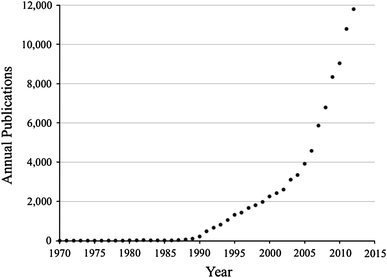
Fig. 1: Frequency of papers published that include sustainability or sustainability in the bibliographic records over time (Kajikawa et. al 2014)
Sustainability made its grand entrance into American culture alongside the environmental movement in the 1960s and 1970s. In the past 20 years, we have seen a considerable uptick in publications on ‘sustainability’ (Fig. 1) and it has rapidly transformed into distinct fields of study (i.e. Sustainability Science & Sustainable Development). Within its brief 50 years of study sustainability’s meaning has been highly scrutinized, redefined, and refined.
Sustainability in the broadest sense means the ability of something to maintain or “sustain” itself over time. Academically, its precise definition has varied from person to person, field to field, but by and large, all definitions include three distinct “dimensions”: social, economic, and environmental. Some academics call these dimensions the three pillars, three components, or three aspects and make attempts to diagram this broad topic (Fig. 2). When attempting to define sustainability academics have found themselves teetering back and forth between vagueness and incomprehensibility. It’s no wonder people get confused!

Fig. 2: Common Sustainability Diagrams. Left, three intersecting circles, Right, literal ‘pillars’ and a concentric circle approach.
It is important to have a strong understanding of sustainability in order to make meaningful progress towards it. Without fully understanding what sustainability is and is not, we run the risk of trivialization and manipulation by those who have something to gain from its misunderstanding. I am sure we all can recall a company that has used sustainability buzz words to grab our attention while they stand behind their Green Washed curtain perpetuating the unsustainable status quo. This is why for the Spring 2022 semester, the Office of Sustainability will be tackling the meaning behind the three dimensions of sustainability. We will review the key points of each dimension as well as interview professors on campus that we believe will help contextualize each dimension of sustainability. We hope to leave you with resources to learn more, campus-specific examples of each dimension, and actions you can take to work toward sustainability.
Our office defines sustainability as:
A multi-disciplinary, problem-solving approach to creating a social system that meets the needs of the present generation without compromising the needs of future generations or the needs of the ecological system in which huamsn exist.
By fostering education that encourages reponsible and equitable management of our envrionmental, social and economic resources, the sustainability framework challenges our university to consider the interdependent nature of our lives, the natural environment, our communities and the economy and especially the improvement of these relationships.
Key Terms:
- Sustainable Development-development that meets the needs of the present without compromising the ability of future generations to meet their own needs (Robertson, 2021)
- Sustainability Science-a field of study devoted to tackling the challenges of sustainable development in the transition toward sustainability. This field is interdisciplinary, defined by the problems it addresses rather than by the disciplines it employs. (Kates, 2010)
Resources & Recommended Reading:
Kates, Robert W., ed. Readings in Sustainability Science and Technology. CID Working Paper No. 213. Center for International Development, Harvard University, December 2010.
Robertson, Margaret. Sustainability Principles and Practice Third Edition. Routledge, Abingdon, OX & Routledge, New York, NY. 2021
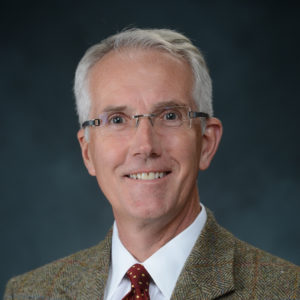



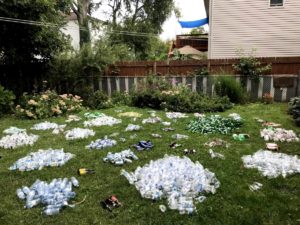

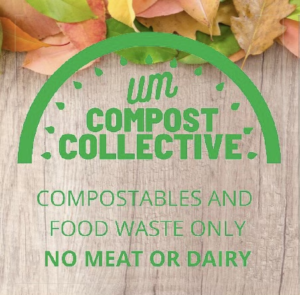 UM Compost Collective
UM Compost Collective
